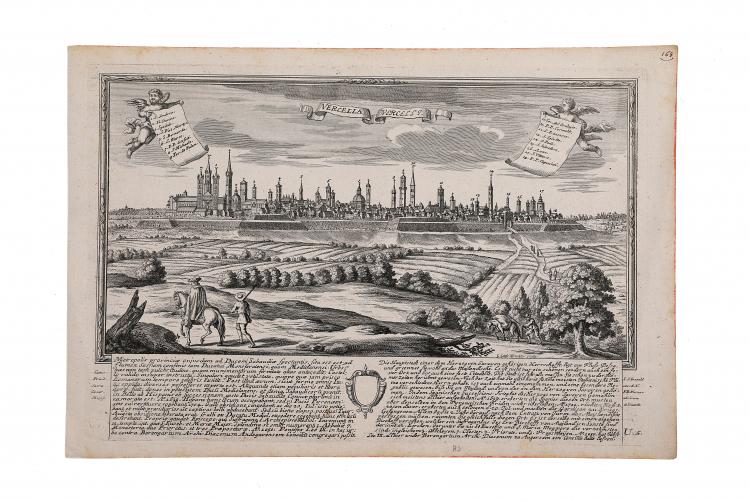1730-1745, Augusta - Incisione, 330x225 mm - Biblioteca diocesana Agnesiana, Vercelli
- Profilo di Vercelli come appariva intorno al 1730, quando ancora ben evidenti erano i resti dei bastioni smantellati dai francesi nel 1704, dopo che la città si era arresa ad un assedio di circa due mesi. L’incisione fa parte di una serie di vedute di città turrite europee, vendute separatamente; pubblicata ad Augsburg (Augusta) tra il 1730 e il 1745 con la seguente sottoscrizione: Winkler sculp. / I.(ohann) C.(hristian) Leopold exc. A.(ugustae) V.(indelicorum) F.(riedrich) B.(ernhard) Werner ad vivum delineavit. Il nastriforme titolo della stampa VERCELLA-VERCELLI è posto in alto, tra due putti alati ognuno dei quali regge un cartiglio recante nove di diciotto richiami che identificano campanili e torri risalenti al periodo medioevale della città. Da sinistra verso destra i richiami sono i seguenti: 1) S. Andrea, 2) Il Duomo, 3) Spedale, 4) S. Pietro Martire, 5) S. Bernardo, 6) S. Marco, 7) P. P. Giesuiti (sic), 8) S. Michaele, 9) Torre da Palazzo, 10) Torre del Orologio, 11) P. P. Carmelitani, 12) S. Francesco, 13) S. Spirito, 14) S. Paolo, 15) S. Salvadore, 16) S. Anna, 17) S. Vittore, 18) P. P. Capuccini (sic). In basso sono riportate notizie sulla storia di Vercelli e del suo territorio: in latino (a sinistra) e in tedesco (a destra). Le due didascalie sono separate da uno scudo il cui campo, qui vuoto, è in altri esemplari occupato da una scritta, probabilmente intesa a personalizzare la stampa. Per esempio, nell’esemplare a colori pubblicato sulla sovracoperta del volume di P. Portinaro e G. Bo, Vercelli nelle antiche stampe (Tacchini, Vercelli 1982), in detto campo compaiono le iniziali M.L.
- Outline of Vercelli as it appeard around 1730, when the the ruins of the bastions destroyed by the French in 1704, after the city surrended to a nearly 2-month siege, were still visible. The engraving (30,5 x 20,5 cm) is part of a series of views of European towered cities, sold separately; published in Augsburg (Augusta) between 1730 and 1745 with the following text: Winkler sculp. / I.(ohann) C.(hristian) Leopold exc. A.(ugustae) V.(indelicorum) F.(riedrich) B.(ernhard) Werner ad vivum delineavit. The title of the engraving VERCELLA-VERCELLI is on a ribbon placed on the top section, between two winged puttos, each one carrying a scroll with nine of the eighteen references identifying Medieval campaniles and towers of the city. From the left to the right, the references are as follows: 1) St Andrews, 2) the Duomo, 3) Hospital, 4) St Peter Martir, 5) St Bernard, 6) St Marc, 7) P.P. Jesuits (sic), 8) St Michael, 9) the Tower of the Palazzo, 10) the Tower of the Clock, 11) P. P. Carmelites, 12) St Francis, 13) St Spirit, 14) St Paul, 15) St Saviour, 16) St Anne, 17) St Vittore, 18) P.P. Capuchin (sic). On the bottom there are some information on the history of Vercelli and its area: in Latin (on the left) and in German (on the right). The two captions are separated by a shield, in this case empty, but in other copies filled in with a text, maybe with the purpose of personalizing the engraving. As an example, the coloured engraving published on the over-coverage of the book by P. Portinaro and G. Bo, “Vercelli in the old engravings” (Tacchini, Vercelli 1982), the initials M.L. appear in the shield (engraving n1, folder maps and views, Diocesian Agnesian Library).
- Profil de Vercelli telle qu’elle apparaissait autour de 1730, quand les ruines des bastions détruit par les français en 1704, à la suite d’un siège d’environ deux mois, étaient encore bien évidents. La gravure fait partie d’une série de vue de villes européennes munies de tours, vendue séparément ; publiées à Augsbourg entre 1730 et 1745 avec l’inscription suivante : Winkler sculp. / I.(ohann) C.(hristian) Leopold exc. A.(ugustae) V.(indelicorum) F.(riedrich) B.(ernhard) Werner ad vivum delineavit. Le titre de la gravure est dans un ruban placé en haut, entre deux putti ailés chacun desquels tient une cartouche avec neuf des dix-huit références qui identifient les clochers et les tours de la ville datant de la période médiévale. De gauche à droite les indications sont les suivantes: 1) Saint-André, 2) le Dôme, 3) L’Hôpital, 4) Saint Pierre Martyre, 5) Saint Bernard, 6) Saint Marc, 7) P.P. Jésuites (sic), 8) Saint Michel, 9) Tour du Palais, 10) Tour de l’Horloge, 11) P.P. Carmélites, 12) Saint François, 13) Saint Esprit, 14) Saint Paul, 15) Saint Sauveur, 16) Sainte Anne, 17) Saint Vittore, 18) P.P. Capucins (sic). Les deux légendes sont séparées par un bouclier dont le champ, ici vide, est dans d’autres exemplaires rempli par du texte, peut-être dans le but de personnaliser la gravure. Par exemple, dans l’exemplaire à couleurs publié sur la jaquette de couverture du volume de P. Portinaro et G. Bo, “Vercelli dans les gravures anciennes” (Tacchini, Vercelli 1982), les initiales M.L. sont présentes à l’intérieur du bouclier.
